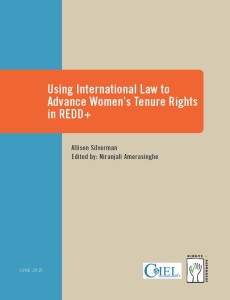
Reducing Emissions from Deforestation and Forest Degradation (REDD+) is an international initiative to mitigate climate change in the forest sector. It is intended to incentivize developing countries to reduce greenhouse gas emissions from deforestation and forest degradation, as well as promote sustainable management of forests, and conservation and enhancement of forest carbon stocks.
REDD+ has significant implications for land and resource rights, and raises particular concerns for women. These concerns arise from discrimination that women already face in resource management processes, largely due to unclear, insecure and unequal tenure rights. Women represent a large percentage of the world’s poor, and they are often directly dependent on natural resources. As a result, there are significant risks that REDD+ could exacerbate existing inequalities for women if it fails to respect women’s tenure rights.
This paper makes a case for advancing women’s tenure rights and how international law can be used to promote those rights in the context of REDD+. It is intended for women’s rights advocates involved in climate change and REDD+, and thus presumes a general familiarity with REDD+. International human rights law is presented as an additional framework for advocates to use in their strategies and messages to advance women’s tenure rights in REDD+. While international law does not specifically address women’s tenure rights, the paper provides a typology of key internationally-recognized human rights that are relevant to women’s tenure rights. The typology groups the most significant rights into five categories: 1) Tenure-related rights 2) women’s and/or gender-specific rights, 3) procedural rights, 4) Free, Prior, and Informed Consent, and 5) the right to a healthy environment. The paper evaluates how each category of rights is articulated in international human rights law. It then uses the typology to highlight the basis for advocating greater attention to women’s rights in REDD+ policies and frameworks – specifically the United National Framework Convention on Climate Change (UNFCCC) and the World Bank’s Forest Carbon Partnership Facility (FCPF).
Read full text. A summary is also available.
